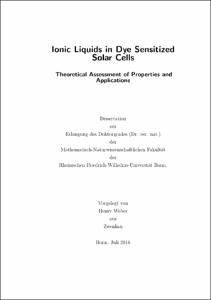Weber, Henry: Ionic Liquids in Dye Sensitized Solar Cells : Theoretical Assessment of Properties and Applications. - Bonn, 2016. - Dissertation, Rheinische Friedrich-Wilhelms-Universität Bonn.
Online-Ausgabe in bonndoc: https://nbn-resolving.org/urn:nbn:de:hbz:5n-45438
Online-Ausgabe in bonndoc: https://nbn-resolving.org/urn:nbn:de:hbz:5n-45438
@phdthesis{handle:20.500.11811/6924,
urn: https://nbn-resolving.org/urn:nbn:de:hbz:5n-45438,
author = {{Henry Weber}},
title = {Ionic Liquids in Dye Sensitized Solar Cells : Theoretical Assessment of Properties and Applications},
school = {Rheinische Friedrich-Wilhelms-Universität Bonn},
year = 2016,
month = dec,
note = {Dye-sensitized solar cells have the potential to play a major role in the future of the global energy economy. Unfortunately, they still lack the consistency and durability to be truly competitive from a commercial point of view. The use of ionic liquids may hold a solution to most of the current drawbacks; thus, the implications of their use in dye-sensitized solar cells are approached by means of quantum chemical calculations and computational modeling.
The pure bulk phase of three promising cyano-based ionic liquids was investigated by ab initio molecular dynamics studies. Differences in cation-cation structuring was revealed despite the fact that all liquids bear the same cation, which might be correlated to macroscopic properties such as viscosity. The semiconductor-electrolyte interface is of special interest, as many processes occur here in a complete device. Characterization of this system was attempted on different pathways: First, the adsorption behavior was investigated in detail for selected cyano-based ionic liquids in order to understand specific interactions. Second, a polarizable molecular dynamics force field was parametrized to study the extended TiO2-ionic liquid interface, focusing on cooperative and bulk phase effects. Third, a great variety of ionic liquids were classified in their ability to shift the energy levels of the semiconductor TiO2. Furthermore, influences of the ionic liquid electrolyte on the sensitizing dye were studied. Directed coordination plays a role, and a universal redshift of adsorption spectra upon solvation with respect to the gas phase is apparent.
Beneficial effects of ionic liquid application can be fine-tuning of semiconductor energy levels or spectroscopic properties of the dye, they can build blocking layers on the surface to prevent unfavored recombination reactions, or can enhance dye regeneration by favorably interacting with the redox mediator. Ultimately, the choice of the ionic liquid decides. Choosing the "right" ionic liquid can certainly have beneficial effects on the dye-sensitized solar cell, whereas choosing the "wrong" ionic liquid will result in inferior properties. By illuminating the fundamental processes involved, the results presented herein shall guide the choice of the ionic liquid electrolyte in future applications.},
url = {https://hdl.handle.net/20.500.11811/6924}
}
urn: https://nbn-resolving.org/urn:nbn:de:hbz:5n-45438,
author = {{Henry Weber}},
title = {Ionic Liquids in Dye Sensitized Solar Cells : Theoretical Assessment of Properties and Applications},
school = {Rheinische Friedrich-Wilhelms-Universität Bonn},
year = 2016,
month = dec,
note = {Dye-sensitized solar cells have the potential to play a major role in the future of the global energy economy. Unfortunately, they still lack the consistency and durability to be truly competitive from a commercial point of view. The use of ionic liquids may hold a solution to most of the current drawbacks; thus, the implications of their use in dye-sensitized solar cells are approached by means of quantum chemical calculations and computational modeling.
The pure bulk phase of three promising cyano-based ionic liquids was investigated by ab initio molecular dynamics studies. Differences in cation-cation structuring was revealed despite the fact that all liquids bear the same cation, which might be correlated to macroscopic properties such as viscosity. The semiconductor-electrolyte interface is of special interest, as many processes occur here in a complete device. Characterization of this system was attempted on different pathways: First, the adsorption behavior was investigated in detail for selected cyano-based ionic liquids in order to understand specific interactions. Second, a polarizable molecular dynamics force field was parametrized to study the extended TiO2-ionic liquid interface, focusing on cooperative and bulk phase effects. Third, a great variety of ionic liquids were classified in their ability to shift the energy levels of the semiconductor TiO2. Furthermore, influences of the ionic liquid electrolyte on the sensitizing dye were studied. Directed coordination plays a role, and a universal redshift of adsorption spectra upon solvation with respect to the gas phase is apparent.
Beneficial effects of ionic liquid application can be fine-tuning of semiconductor energy levels or spectroscopic properties of the dye, they can build blocking layers on the surface to prevent unfavored recombination reactions, or can enhance dye regeneration by favorably interacting with the redox mediator. Ultimately, the choice of the ionic liquid decides. Choosing the "right" ionic liquid can certainly have beneficial effects on the dye-sensitized solar cell, whereas choosing the "wrong" ionic liquid will result in inferior properties. By illuminating the fundamental processes involved, the results presented herein shall guide the choice of the ionic liquid electrolyte in future applications.},
url = {https://hdl.handle.net/20.500.11811/6924}
}






